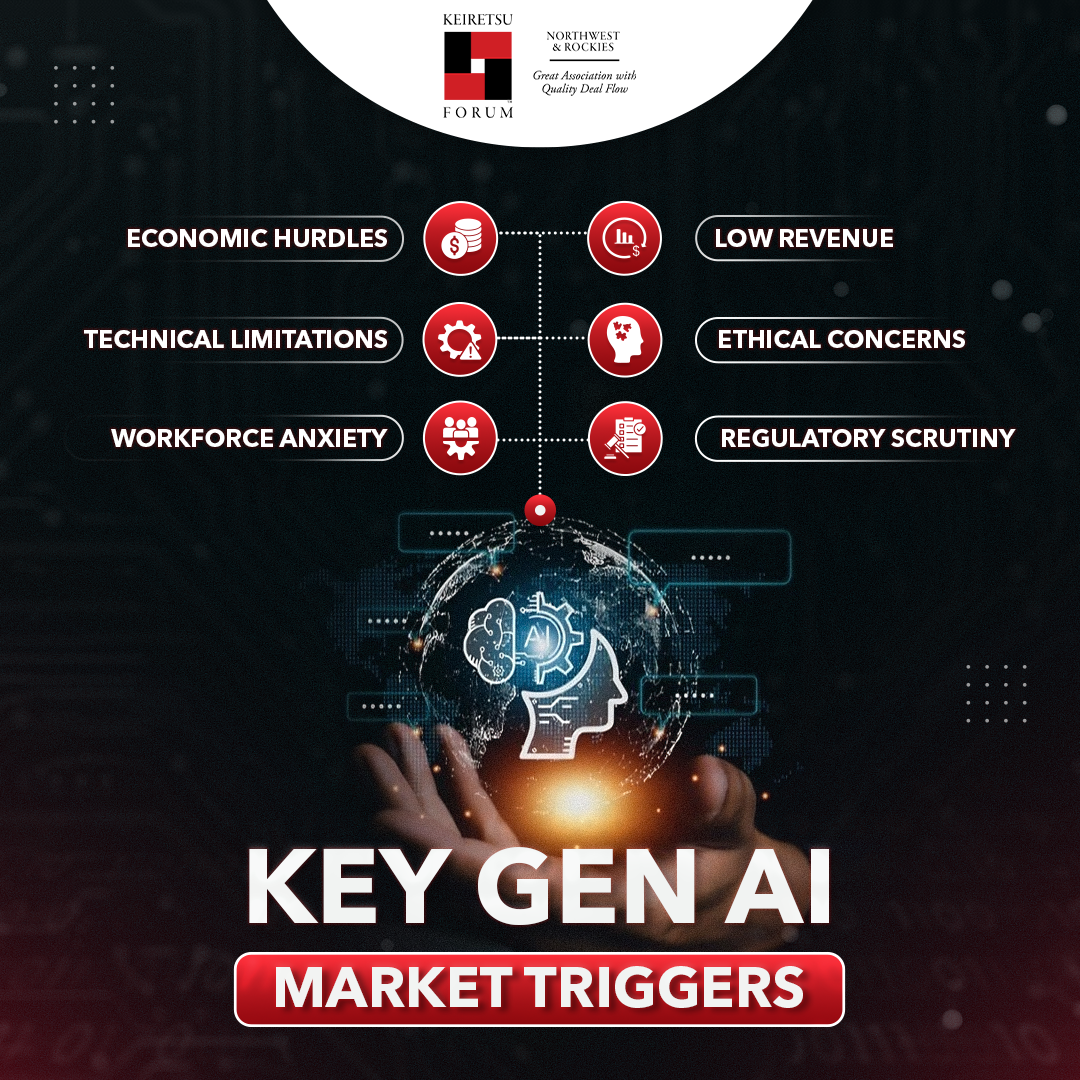
In the last few decades, several innovative ideas have shaped our lives, but nothing is more revolutionary than Artificial Intelligence. AI is no longer a sci-fi concept; it's a reality weaving its way into every aspect of our lives, from the apps we use to the cars we drive. But as AI advances at a breakneck pace, a question looms large: Are we ready for the consequences? Are we prepared for a world where machines can think, learn, and even surpass human capabilities? And most importantly, are we on the brink of a future where robots replace us?
In this blog, we share Ronald Weissman’s thoughts on the capabilities of current-gen AI, its challenges for evolution, and what it means for investors who want to get in early.
Gen AI Bubbles and Beyond: What’s Next?
The startup funding landscape appears to be improving, with increased valuations and more money flowing into the ecosystem. However, this perception is largely driven by the disproportionate impact of AI investments:
· 20% of deals in the last quarter were AI-related
· 47% of the increase in startup funding came from AI deals
· 60% of the increase in valuations was attributed to AI
· 40% of deal value in the first half of the year was AI-focused
When we subtract AI from the equation, the picture becomes more realistic. Most other sectors, with the exception of biotech, are still struggling. Deal volumes are falling, and only the top-performing companies are securing substantial funding. Many startups face longer financing processes, worse terms, and, in some cases, "pay-to-play" rounds that could lead to investor dilution.
Several factors drive the current AI boom:
-
We're now in the sixth generation of AI, marked by large language models.
-
Transformers, introduced by Google in 2017, revolutionized language processing.
-
Major tech companies like Microsoft, Meta, Apple, Amazon, Google, and Oracle (dubbed "MAANGOs") are leading the acquisition spree.
-
In the past six years, $500 billion has been invested in AI, resulting in 43,000 new companies. About $50 billion has been invested in chat models alone.
While AI is undoubtedly driving innovation and attracting substantial investment, it's crucial to recognize that this sector's success is not representative of the broader startup ecosystem. The apparent recovery in early-stage investing is essentially an AI-driven phenomenon, masking ongoing challenges in other sectors.
Startup Recovery May Take Longer: Here’s Why
The potential for further delay in startup recovery is a growing concern, mainly due to the distorting effect of the AI bubble on the overall market perception. While the current narrative suggests a thriving startup ecosystem, this optimism is fueled by the massive influx of capital into AI-related ventures.
The AI sector has seen unprecedented growth in valuations, significantly outpacing other markets. Early-stage AI companies are commanding a median valuation of $70 million, compared to $50 million for Fintech and $46 million for SaaS startups. This represents at least a 50% premium for AI companies, indicating a potentially unsustainable trend.
The situation is even more extreme in the Generative AI space. Pre-seed and seed valuations for these companies have skyrocketed from $92 million last year to $250 million this year. This rapid escalation mirrors the bubble-like conditions observed in 2021, with early-stage valuations jumping from $10 million to $14 million, mid-stage from $60 million to $100 million, and late-stage from $92 million to $250 million.
These inflated valuations are accompanied by bubble-like revenue multiples reminiscent of the dot-com boom in 2000 and the recent 2021 bubble. Companies like Hugging Face are valued at 150 times their revenues, while legal analytics firm Harvey commands a staggering 71 times revenue multiple.
While exits for AI companies have shown some improvement in the most recent quarter, many of these exits have been acquisitions by major tech companies. This trend suggests that even well-funded, top-tier AI startups are struggling to compete independently and are opting to be acquired by giants like Google and Meta.
The overall investment landscape in AI reveals a concerning imbalance. Since 2018, approximately $500 billion has been invested in AI, while only $400 billion has been returned. The net negative cash flow indicates that more money is poured into deals than recouped through returns.
If the AI bubble were to burst, it could have severe repercussions for the broader investment ecosystem. The artificially inflated valuations and excessive capital inflow in the AI sector are masking underlying weaknesses in other areas of the startup market. A sudden deflation of the AI bubble could expose these vulnerabilities, making the overall recovery for growth-stage companies even more challenging and prolonged.
Why AI Startups Can’t Escape the Current Business Trends?
Despite the excitement surrounding artificial intelligence, AI businesses are not immune to the current business cycle and economic headwinds. Tech layoffs are reducing enterprise technology purchases, including AI solutions. Weak corporate earnings are making companies more cautious about large AI deployments. The rapid pace of AI development is also causing some buyers to hesitate, fearing that today's technology will quickly become obsolete.
The challenging fundraising environment for venture capital is making it harder for AI companies to raise capital in the second half of this year. Some larger private AI companies are already seeing their valuations cut. Major tech companies are acquiring well-funded AI startups at more modest 2-3x multiples.
At the same time, companies are scaling back their AI spending plans. In China, the percentage of companies planning to increase AI spending in 2024 has dropped from 100% to less than half. Globally, the share of companies increasing AI spending has fallen from 93% to 63%. Gartner predicts that 30% of generative AI projects will be abandoned, partly due to disappointing results and partly because sponsors are realizing the high costs involved—often thousands or tens of thousands of dollars per employee.
The AI hype cycle is at its peak, with generative AI poised to enter the "trough of disillusionment." This follows a historical pattern of AI booms and busts. Breakthroughs like transformers or backpropagation spark excitement and over-investment, followed by a period of applied development. Eventually, reality fails to match the hype, leading to an "AI winter" of reduced investment.
However, this doesn't mean AI's potential has diminished. After the hype cycle runs its course, AI technologies often reemerge with more realistic expectations and practical applications. Despite facing some headwinds, the current wave of AI development still offers significant opportunities for innovation.
While a complete collapse of the Gen AI market is unlikely, a significant pullback or recalibration appears imminent. Companies that can address the technical, ethical, and economic challenges while delivering tangible value in specific verticals are best positioned to weather the storm. As the hype cycle peaks, investors and businesses should prepare for a more realistic assessment of AI's capabilities and limitations. This reset could ultimately lead to more sustainable and responsible development of AI technologies.
“Market sentiments can turn on a dime” – Ron Weissman.
Challenges to Unlocking The Full Potential of AI
To advance artificial intelligence beyond its current capabilities, several key challenges need to be addressed:
Efficient AI Processing: The shift from "red AI" to "green AI" is crucial. Current AI systems often require massive data centers, consuming enormous energy. Developing more efficient AI that can operate with less computational power is a priority. This includes improving chip design specifically for AI processing to maximize performance while minimizing energy consumption.
Data Scarcity and Quality: Despite the era of big data, high-quality, diverse datasets for training AI models remain scarce. Synthetic data generation has not proven an adequate solution, often leading to poorer results. Creating or curating better training data is essential for advancing AI capabilities.
Smaller, More Manageable Models: There's growing interest in moving from large language models to smaller, more efficient ones. The challenge lies in approximating the performance of massive models (like those with 340 billion parameters) using significantly fewer parameters. This would make AI more accessible and easier to deploy across various applications.
Standardization in Data Science: Much of data science currently relies on trial and error - more akin to alchemy than a standardized discipline. The field lacks:
-
Standard benchmarks
-
Consistent evaluation frameworks
-
Comprehensive catalogs and sandboxes
Developing these tools would allow for more systematic approaches to matching AI models to specific problems, moving away from the current trial-and-error methodology.
Ethical AI Development: As AI becomes more prevalent, ensuring its ethical development and deployment is crucial. This includes addressing bias and transparency issues in AI systems.
New Technical Foundations: A number of technical advancements could significantly improve AI capabilities, such as:
-
Task sharing between handheld devices and data centers to enhance user interaction.
-
Transferring knowledge between different AI models more effectively.
-
Moving from pattern recognition to explanatory models that can provide insights into their decision-making processes.
-
Combining neural and symbolic AI approaches. Companies like SRI, IBM, and Extensus are pioneering research in integrating rule-based systems with neural networks.
By addressing these challenges, the AI field can move towards more efficient, ethical, and capable systems that can better serve a wide range of applications. The future of AI likely lies not in competing approaches but in finding ways to integrate and reinforce different methodologies for more robust and versatile artificial intelligence.
Investing Beyond Generative AI: Emerging Opportunities in AI Innovation
While generative AI has captured significant attention and investment, several other promising areas of AI development offer compelling opportunities for investors and innovators:
Explainable AI (XAI): Explainable AI aims to make AI systems more transparent and interpretable. This field is crucial for building trust in AI applications, especially in high-stakes domains like healthcare and finance. As AI becomes more prevalent in decision-making processes, the ability to understand and explain AI outputs will be increasingly valuable.
Lean and Green AI: This emerging field focuses on developing AI systems that are more energy-efficient and environmentally friendly. As AI models grow in size and complexity, their energy consumption becomes a significant concern. Lean and green AI aims to address this issue by creating more efficient algorithms and hardware.
Sense-Making AI: Sense-making AI systems integrate multiple sensory inputs to understand and interpret complex environments. For example, the Canadian Air Force uses a sense-making tool to monitor airspace activity for its pilots. This technology has applications in various fields, from military operations to urban planning and environmental monitoring.
Affective AI: Affective AI, which focuses on recognizing and responding to human emotions, is gaining traction. A notable development is that one American state has approved using AI as a lie detector due to its proficiency in detecting human emotions. This technology has potential applications in customer service, mental health, and law enforcement.
Trusted AI: Building trust in AI systems is critical for widespread adoption. Trusted AI encompasses various approaches to ensure AI systems are reliable, secure, and aligned with human values. This field is crucial for consumer-facing AI applications.
AI Chips: Developing specialized AI chips is crucial for processing the next generation of AI models. These chips are designed to handle the unique computational requirements of AI algorithms more efficiently than traditional processors.
AI Compliance: As AI becomes more pervasive, regulatory compliance is becoming increasingly important. This is particularly true in Europe, where strict AI regulations are being implemented, and similar trends are expected in the US. AI compliance will be crucial for any technology that interacts with humans.
Neural-Symbolic AI: This approach combines neural networks with symbolic reasoning to create AI systems that can perform pattern recognition and logical reasoning. Neural-symbolic AI is still in its early stages but shows promise in addressing some limitations of current AI systems.
Investment Focus: Given the early stage of many of these technologies, investors should focus on capital-efficient companies solving near-term problems. A key differentiator in the current market is access to high-quality, real-world data for training effective AI models across all these emerging fields.
Be Realistic About Investor Returns
Investing in AI startups can be alluring, but it's crucial to maintain realistic expectations about potential returns. A study examined over a thousand seed-stage companies across various sectors, including AI, after 8-9 years. The results provide a sobering perspective:
-
Less than 0.5% of companies became unicorns
-
Only 11% were sold for $500 million or more
-
14% chance of any exit after 8-9 years
While multi-billion dollar returns happen in AI investments, they are exceedingly rare. Investors must approach AI opportunities with the same rigorous due diligence applied to any other sector:
-
Validate the business model
-
Confirm management's claims through thorough research
-
Assess risk acceptability
-
Ensure deal terms are appropriate
-
Compare potential risks against likely returns
The average funding needed to reach an M&A exit is approximately $35 million. As funding requirements increase, so do the risks of breakdowns, liquidation preference issues, and dilution. Investors must carefully consider how much capital a startup needs and understand their risk exposure.
When evaluating AI investments, consider the following checklist:
-
Team quality: Is the team genuinely world-class in AI?
-
Technology legitimacy: Is it genuine AI or repackaged business intelligence?
-
Intellectual property: Does the company have real IP, or is it just another wrapper for existing AI models?
-
Product-market fit: Has this been validated or based on speculation?
-
Problem-solving: Is the AI addressing a real problem or just a technological curiosity?
-
Business focus: Is the goal to build an algorithm or a sustainable company?
-
Market interest: Are mainstream customers interested, or is it limited to tech companies, universities, and government labs?
-
Bias mitigation: Is there a strategy for detecting and addressing AI bias?
-
Data strategy: How will the company acquire and manage the necessary data?
-
Scalability: What are the costs and challenges of scaling the AI solution?
-
Financing roadmap: How many funding rounds are anticipated?
-
Exit potential: Is there a realistic path to acquisition or public offering?
By thoroughly evaluating these factors, investors can make more informed decisions about AI investments and set realistic expectations for returns in this exciting but challenging sector.
About The Speaker
Ronald Weissman is a seasoned professional with over 40 years of experience in venture capital, technology, and angel investing. He is currently the Chair of the Angel Capital Association and has held leadership positions at various organizations, including Band of Angels, Neva SGR, and Performance Works. Weissman's expertise spans enterprise software, SaaS, digital health, and more forward-looking sectors. He has also served as an advisor and board member for numerous startups and has a strong technology strategy and business development background.


